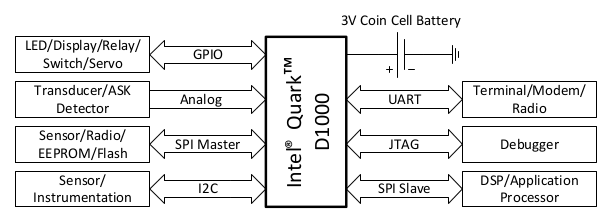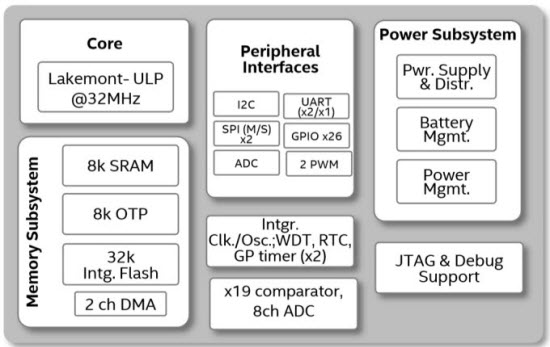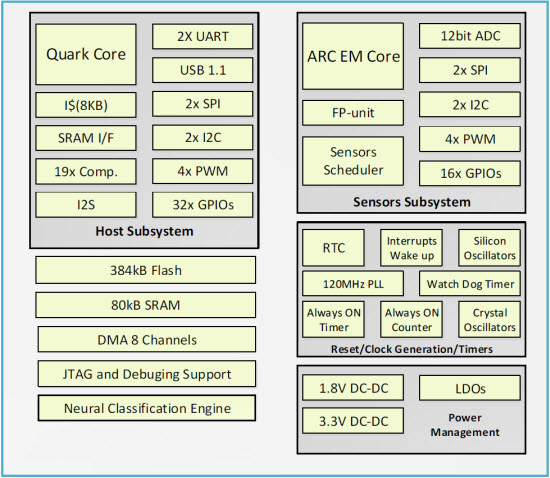Intel’s subsidiary, Wind River, has recently announced two operating systems for the Internet of things with Rocket RTOS and Pulsar Linux supported respectively by Quark MCUs, and Intel Atom processors, as well as some ARM SoCs. But it’s not the only “IoT” announcement made by Intel in the last week, as I found out via EETimes that the company also unveiled three new Quark SoCs, namely Quark D1000, and Quark D2000, and Quark SE.
Intel Quark D1000

Contrary to previous Quark processor and the upcoming D2000 and SE processors, D1000 is not compatible with x86 instructions set, and features the following:
- 32-bit Harvard CISC CPU @ 33 MHz with single cycle barrel shifter, two cycle multiplier, multi-cycle divider, integrated 32-bit timer, programmable interrupt controller, and JTAG debugger.
- 128-bit wide 32 kB code flash and 8 kB ROM
- 32-bit wide 8 kB SRAM and 4 kB data flash
- Osciallators
- 20-33 MHz crystal oscillator for low jitter precision frequency and 4-32 MHz silicon oscillator for reduced power.
- 32 kHz low power crystal oscillator and real-time clock
- Peripherals and IOs
- 19-channel 12-bit 2.4 MSps SAR ADC
- 6x high-speed and 13x low-power comparators
- 32-bit watchdog timer
- 2x 32-bit general purpose timers with independent clock frequencies.
- 24x general purpose I/O with edge detection and interrupt capability.
- 16 Mbps SPI master and slave interfaces supporting Motorola SPI, Texas Instruments SSP and National Semiconductor Microwire formats.
- I2C master/slave interface supporting both 100 kbps standard and 400 kbps fast modes.
- 2x UARTs with hardware handshaking.
- 24x ESD-protected versatile digital I/O buffers with high current drive and programmable direction, slew rate, and pull-up control.
- 19x ESD-protected analog inputs sharing the same pins as digital I/O for fast wake up from digital or analog input signals.
- Low Power Features
- Sleep regimes down to 1.5 μA.
- Wake up in as little as 2.0 μs.
- Active regimes down to 320 μA.
- 300 μA low quiescent current linear VR for low power sleep regimes and 50 mA buck VR for active regimes and off chip devices.
- Power Supply Range – 1.62-3.63 V.
- Temperature Range – -40°C to 85°C
- Package – QFN40; 6×6 mm
Intel Quark D1000 product page is up, where you can read a shorter features summary, and access the datasheet and a user guide. Intel still publishes TDP for Quark, and it might be the first true low power Intel micro-controller with 0.025W TDP @ 33MHz, and 1.6mW configurable TDP @ 1 MHz. Intel expects D1000 MCU to target “battery-powered and line-powered sensors to provide secure, intelligent processing for wired and wireless real-world applications at the edge”.
Intel Quark D2000

Quark D2000 has a more powerful x86 core:
- CPU – 32-bit processor @ 32 MHz Intel Pentium x86-compatible without x87 floating point unit
- Flash – 32 KB instruction + 8 KB data
- RAM – 8 KB
- Peripherals and I/Os
- 25x independently configurable General-purpose I/O
- 2x General-use timers
- 2x PWM (Pulse width modulator)
- Watchdog timer – Resolution from 8 μs to ~60 s (running at 32 Mhz)
- Real-time clock – Sources a 32-bit counter running from 1 Hz up to 32.768 KHz
- 2x UART 16550-compliant interfaces, 2x SPI (1 master with up to 4 devices, 1 slave), 1x I2C (master/slave)
- 19-channel SAR ADC (12/10/8/6-bit@2.4/2.8/3.3 MSps); 1.8~3.6V
- 19 analog comparators: 6 high-performance & 13 low-power
- 2x unidirectional DMA channels
- Security – Secure update, 8k OTP, JTAG lock, isolated SRAM regions, on-die NVM read/write access control
- Crystal oscillators – (externally generated) 32 MHz & 32.768 KHz
- Silicon oscillator – (internally generated) 32 MHz & 32.768 KHz
- 4/8/16/32 MHz CPU clock generator ; Low-power compute mode w/RTC clock source
- Voltages – PCDD: 1.8–3.63 V; AVDD: 2.0–3.63 V; IOVDD: 1.8–3.63 V; DVDD: 1.8 V +/- 10%
- Power supply – DC-DC 2.0 V, 3.3 V
- Temperature Range – -40 °C to +85 °C
- Package – 40-pin QFN, 6×6 mm
Intel Quark D2000 product page provides access to a product brief, but the datasheet is only available to holders of “Intel Embedded Design Center (Intel EDC) Privileged account”. D2000 micro-controllers are expected to be used in industrial applications (smart readers), medical applications (sensor and device controllers), for display controllers in the retail space, and motor controllers in buildings.
Intel Quark SE

Intel Quark SE shares somes of Quark D2000 features but with extra goodies such as more memory and storage, an instruction cache, a sensor subsystem (DSP), a pattern-matching accelerator, more I/Os, etc…:
- CPU – 32-bit processor @ 32 MHz Intel Pentium x86-compatible without x87 floating point unit, and with 8 KB instruction cache
- Sensor subsystem – 32-bit DSP core @ 32 MHz supporting ARCv2 ISA and floating point unit, with 8 KB instruction cache, and 8 KB DCCM (Data Closely Coupled Memory)
- Pattern-matching accelerator – 128 neurons with 128 components per neuron
- Flash – 384 KB on-die flash: 192 KB dedicated to host processor, 192 KB dedicated to sensor system. 8 KB OTP
- RAM – 80 KB on-die SRAM
- Peripherals and I/Os:
- 32x independently configurable General-purpose I/O, 16x extra GPIOs via sensor subsystem (DSP)
- 4x General-use timers
- Watchdog timer
- Real-time clock – Sources a 32-bit counter running from 1 Hz up to 32.768 KHz
- 2x UART 16550-compliant interfaces, 3x SPI (2 master with up to 4 devices, 1 slave), 4x I2C (2x master/slave, 2x master only on the DSP)
- USB – 1.1 device-only controller
- 2x I2S interfaces: 1x transmit interface, 1x receive interface
- Single ADC controller in DSP: 19 single-ended inputs, 12-bit resolution
- 19x analog comparators: 6 high-performance & 13 low-power
- 8x unidirectional DMA channels
- Security – 8k OTP, JTAG lock, on-die NVM read/write access control
- Crystal oscillators – (externally generated) 32 MHz & 32.768 KHz
- Silicon oscillator – (internally generated) 32 MHz & 32.768 KHz
- 4/8/16/32 MHz CPU clock generator ; Low-power compute mode w/RTC clock source
- Power Supply – 1.8V to 3.3V
- Temperature Range – -40 °C to +85 °C
- Package – 144-pin BGA, 10×10 mm
Intel Quark SE product page also only has the product brief currently publicly available, and Intel targets the same applications as Intel Quark D2000.
All three platforms will be supported by Intel System Studio for Microcontrollers, an Eclipse-based suite, but I could not find much details about this tool so far, and it’s unclear if it is the same, and if not, how much it differs from Intel System Studio for IoT.
The Intel Quark D1000 MCU is available right now, while Intel Quark D2000 will be available by the end of the year, and Intel Quark SE SoC is scheduled for H1 2016. Beside product pages on Intel website listed above, you could also find some more info on Mouser’s Quark D1000, Quark D2000, and Quark SE pages where I found some block diagrams. [Update: Quark D1000 price is $3.9 for one piece, and $2.6 per unit for 1k order on Mouser]

Jean-Luc started CNX Software in 2010 as a part-time endeavor, before quitting his job as a software engineering manager, and starting to write daily news, and reviews full time later in 2011.
Support CNX Software! Donate via cryptocurrencies, become a Patron on Patreon, or purchase goods on Amazon or Aliexpress





If these cost more than $2 they aren’t interesting. Knowing Intel they will be $15-20.
the D1000 appears to be available now from mouser.com for $3.90 in single quantity, and $2.60 for 1K units…
Big thumbs up 😀
Also, good luck competing with ARM and MIPS, I doubt Intel has anything to compete with here in terms cost, performance, power efficiency, features or anything else.
Quark D1000 is non-x86 compatible and Quark D2000 is x86-compatible. There’s not enough confusion in that, Intel! Just name them both Quark D1500 and let customer have an intrigue what they get.
From the programmers manual: https://www-ssl.intel.com/content/dam/www/public/us/en/documents/manuals/quark-d1000-programmer-reference-manual.pdf
It seems that it is mostly compatible, it is like an i386 removing PUSHA/POPA/XCHG, string instructions and segmentation, so it will need minor modifications to compilers supporting IA32.
Well ESP8266 with the works is $2 for the module itself and $5 for the board and this includes shipping … so yeah good luck to Intel 🙂
Soon they’ll have the ESP32 which is dual core and includes even more … It’s not like I have stock at ESP or anything but the prices these guys manage to achieve … it’s just outstanding.
@Marius Cirsta
As discussed in the neighbor topic, they achieve dirt cheapp price for a product which nobody uses (except for arduino kids). They’d better sell it at the higher price and for the difference, hire good marketing team which would sell it into everybody’s face, so nobody could escape. That’s exactly what Intel does well.
@Paul
Well for them that may work out better but I’m happy with getting such a good SOC for such a low price. If I were doing business I’d be even happier ….
I wish Intel the best of luck but IMO the competition on the IOT front is pretty fierce, it’s not like for high end CPU. Intel barely manages to penetrate markets when competing against lots of companies ( see their mobile business where Atom is having a really hard time ).
There’s an Intel Quark D1000 customer reference board, but I can’t find it for sales.
User guide @ http://www.intel.com/content/www/us/en/embedded/products/quark/mcu-d1000/quark-d1000-crb-user-guide.html
Intel IDE @ https://firmware.intel.com/sites/default/files/intelide.zip
it seems already too late: no radios, no networking, no can, and it seems limited power management
the dsp could be very effective though in some applications.